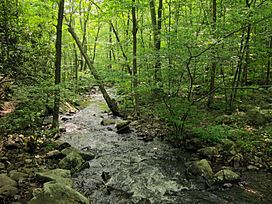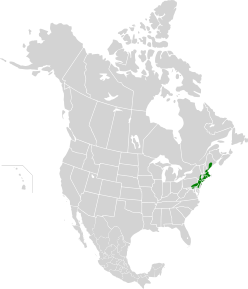Northeastern coastal forests facts for kids
Quick facts for kids Northeastern coastal forests |
|
|---|---|

|
|
 |
|
| Ecology | |
| Realm | Nearctic |
| Biome | Temperate broadleaf and mixed forests |
| Borders |
List
|
| Bird species | 251 |
| Mammal species | 63 |
| Geography | |
| Area | 89,691 km2 (34,630 sq mi) |
| Country | United States |
| States | |
| Conservation | |
| Habitat loss | 40.8% |
| Protected | 6.2% |
The Northeastern coastal forests are a special natural area. It is a type of ecoregion with temperate broadleaf and mixed forests. This means it has both trees that lose their leaves and trees that stay green all year.
This ecoregion is found in the northeast and middle Atlantic parts of the United States. It covers a huge area of about 34,630 square miles (89,691 square kilometers). You can find these forests in parts of Maine, New Hampshire, Massachusetts, Rhode Island, Connecticut, New York State, New Jersey, Pennsylvania, Delaware, and Maryland.
The Atlantic Ocean is to the east of these forests. To the north, they meet the New England-Acadian forests. To the west, they connect with the Allegheny Highlands forests and the Appalachian-Blue Ridge forests. South of these forests are the Southeastern mixed forests and the Middle Atlantic coastal forests. The unique Atlantic coastal pine barrens ecoregion is also found within this area.
Contents
Climate and Weather in the Forests
The weather in the Northeastern coastal forests changes a lot from north to south. In the northern parts, it has a humid continental climate. This means it has warm summers and cold winters. As you go south, the climate becomes more humid subtropical climate. This means it has hot, humid summers and mild winters.
Trees and Plants of the Forests
Oak trees are very common in these forests. Long ago, the American chestnut tree was also very important. But a disease called chestnut blight nearly wiped them out in the early 1900s.
Dry Oak Forests
These forests are found in many places at lower and middle elevations. They usually grow on flat or gently rolling land. Common oak trees here include red oak, white oak, and black oak.
Other trees you might see are:
- Hickory trees
- Red maple and sugar maple
- White ash and tulip trees
- American beech and black cherry
- Black birch and black tupelo
- American elm
Flowering dogwood is a smaller tree that grows under the taller trees.
Common shrubs in these areas are maple-leaved viburnum, spicebush, and witch hazel. If the soil is sandy or acidic, you might find mountain laurel, blueberry, huckleberry, and swamp azalea. A common plant on the ground is mayapple.
Hemlock and Northern Hardwood Forests
These forests grow in moist, sheltered spots like deep coves and ravines. They often have sugar maple, yellow birch, and beech trees. These trees usually lose their leaves in the fall.
Sometimes, you'll also find evergreen trees like hemlock or white pine mixed in. Other trees here include oaks (especially red oak), tuliptree, black cherry, and sweet birch. In the far north, red spruce can also be found.
Dry Oak-Pine Forests
These forests grow in dry areas with loamy or sandy soils. They are a mix of oak and pine trees. Common trees include chestnut oak, Virginia pine, and white pine. Sometimes, white oak or scarlet oak are also present.
The amount of oaks and pines can vary. So, you might see mostly oak forests, mixed oak-pine forests, or small pine forests. Shrubs like hillside blueberry, black huckleberry, and mountain laurel are common. They can sometimes form a thick layer under the trees.
Pine-Oak Rocky Woodlands
These woodlands are found on hilltops, rocky slopes, and places where rocks stick out of the ground. They often look patchy or open. Pitch pine and Virginia pine are common here.
These pines often grow with oaks that like dry places. These include chestnut oak, bear oak, northern red oak, and scarlet oak. You might also find sprouts of American chestnut trees. In the northeast, eastern red-cedar or hophornbeam can be important.
The ground layer can have a thick layer of heath shrubs. Other areas might have more grasses and similar plants, especially under the oak trees.
New Plant Communities
Sometimes, old farms or cleared land are left alone. Over time, new plants start to grow there. Eastern red cedar trees are often some of the first trees to appear in these areas.
Wetlands: Marshes and Swamps
Wetlands are areas where the land is wet for much of the year.
- Marshes are places where water stands for most of the year. Common reed and cattails often grow in large numbers here.
- Swamps and floodplains are wet for only part of the year. Red maple is a common tree in these areas. You might also find swamp tupelo, white ash, American elm, pin oak, swamp white oak, and silver maple. Spicebush is a common shrub. Skunk cabbage is another plant found here.
Animals of the Forests
Many different animals call the Northeastern coastal forests home. Some of the animals you might see include:
- White-tailed deer
- Eastern gray squirrels and chipmunks
- Red foxes and coyotes
- Black bears and beavers
- Woodchucks and raccoons
Birds like sparrows and chickadees are also common.
Reptiles like copperheads, rattlesnakes, northern water snakes, box turtles, snapping turtles, and garter snakes live here. You can also find snails.
Chickadees, white-tailed deer, and eastern gray squirrels are often seen. Gray wolves used to live here, but they are no longer found in these forests. Now, eastern coyotes have taken their place. Very rarely, Moose might be seen in the northernmost parts of these forests.
Protected Natural Areas
Many special natural areas are protected within this ecoregion. These places help keep the forests and their animals safe.
- New Hampshire
- Massachusetts
- Douglas State Forest
- Freetown-Fall River State Forest
- Hockomock Swamp
- Parker River National Wildlife Refuge
- Frederick Weston Memorial Forest
- Wompatuck State Park
- Rhode Island
- Arcadia Management Area
- Great Swamp Management Area
- Connecticut
- Meshomasic State Forest
- Natchaug State Forest
- Pachaug State Forest
- Yale-Myers Forest
- New York
- Bear Mountain State Park
- Black Rock Forest
- Clarence Fahnestock State Park
- Harriman State Park
- Hudson Highlands State Park
- Oyster Bay National Wildlife Refuge
- Sterling Forest State Park
- Storm King State Park
- New Jersey
- Abram S. Hewitt State Forest
- Cheesequake State Park
- Great Piece Meadows
- Jenny Jump State Forest
- Mahlon Dickerson Reservation
- Norvin Green State Forest
- Rancocas State Park
- Ringwood State Park
- Troy Meadows
- Wawayanda State Park
- Pennsylvania
- Hopewell Big Woods
- Ridley Creek State Park
- Evansburg State Park
- French Creek State Park
- Maryland
- Patuxent River State Park
- Elk Neck State Forest
- Elk Neck State Park
- Delaware
- White Clay Creek State Park
- Brandywine Creek State Park
- Cedar Swamp Wildlife Area


